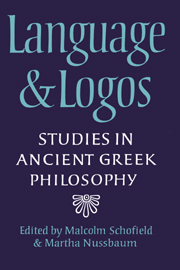Book contents
- Frontmatter
- Contents
- Preface
- Introduction
- 1 Heraclitus' conceptions of flux, fire and material persistence
- 2 Epistemology and meaning in Heraclitus
- 3 The dénouement of the Cratylus
- 4 Cratylus' theory of names and its refutation
- 5 Knowledge and language: the Theaetetus and the Cratylus
- 6 Falsehood and not-being in Plato's Sophist
- 7 Forms and dialectic in the second half of the Parmenides
- 8 Aristotle and the more accurate arguments
- 9 Aristotle on the principles of change in Physics I
- 10 Aristotle on natural teleology
- 11 Accidental unities
- 12 Aristotle's concept of signification
- 13 Saving Aristotle's appearances
- 14 Myths about non-propositional thought
- 15 Gods and heaps
- Bibliography of the publications of G. E. L. Owen
- Index locorum
- Index of names
11 - Accidental unities
Published online by Cambridge University Press: 09 October 2009
- Frontmatter
- Contents
- Preface
- Introduction
- 1 Heraclitus' conceptions of flux, fire and material persistence
- 2 Epistemology and meaning in Heraclitus
- 3 The dénouement of the Cratylus
- 4 Cratylus' theory of names and its refutation
- 5 Knowledge and language: the Theaetetus and the Cratylus
- 6 Falsehood and not-being in Plato's Sophist
- 7 Forms and dialectic in the second half of the Parmenides
- 8 Aristotle and the more accurate arguments
- 9 Aristotle on the principles of change in Physics I
- 10 Aristotle on natural teleology
- 11 Accidental unities
- 12 Aristotle's concept of signification
- 13 Saving Aristotle's appearances
- 14 Myths about non-propositional thought
- 15 Gods and heaps
- Bibliography of the publications of G. E. L. Owen
- Index locorum
- Index of names
Summary
For if not the philosopher, who will it be who investigates whether Socrates and Socrates seated are the same?
(Metaph. iv 2, 1004b1–3)In chapter 11 of his de Interpretatione Aristotle tries to explain why certain features of a thing go together to make up a unity, whereas others do not. ‘For example,’ he says, ‘a man is perhaps an animal and two-footed and tame, and from these there does come to be some one thing’ (2ob16–8). But ‘from white and man and walking,’ he adds, ‘there is not one thing’ (2ob18–19).
The reasoning in this chapter is intricate; but without tracing out the intricacies we can perhaps say that the unity Aristotle is seeking here is the oneness of an individual substance. In this passage he is unwilling to count as a unity the parasitic oneness that is enjoyed by features only accidentally compresent in a single substance. Though it may be true to say, he remarks later on in the chapter, ‘The white is musical’ (that is, presumably, ‘The white person, is musical’), still, he warns, musical white and white musical (contrast: two-footed animal) are not one thing (21a7–14).
Aristotle later softens his position. He allows, in Metaphysics v 6, for example, that there is such a thing as an accidental unity (hen kata sumbebēkos). The musical and the just, he says, make up an accidental unity because musicality and justice are accidents of one substance (1015b21–2).
- Type
- Chapter
- Information
- Language and LogosStudies in Ancient Greek Philosophy Presented to G. E. L. Owen, pp. 223 - 240Publisher: Cambridge University PressPrint publication year: 1982
- 31
- Cited by



